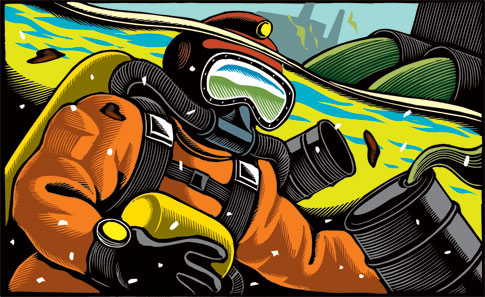Water Pollution (1/7)
Industrial Pollution

In the United States, industry is the greatest source of pollution, accounting for more than half the volume of all water pollution and for the most deadly pollutants. Some 370,000 manufacturing facilities use huge quantities of freshwater to carry away wastes of many kinds. The waste-bearing water, or effluent, is discharged into streams, lakes, or oceans, which in turn disperse the polluting substances. In its National Water Quality Inventory, reported to Congress in 1996, the U.S. Environmental Protection Agency concluded that approximately 40% of the nation's surveyed lakes, rivers, and estuaries were too polluted for such basic uses as drinking supply, fishing, and swimming. The pollutants include grit, asbestos, phosphates and nitrates, mercury, lead, caustic soda and other sodium compounds, sulfur and sulfuric acid, oils, and petrochemicals.
In addition, numerous manufacturing plants pour off undiluted corrosives, poisons, and other noxious byproducts. The construction industry discharges slurries of gypsum, cement, abrasives, metals, and poisonous solvents. Another pervasive group of contaminants entering food chains is the polychlorinated biphenyl (PCB) compounds, components of lubricants, plastic wrappers, and adhesives. In yet another instance of pollution, hot water discharged by factories and power plants causes so-called thermal pollution by increasing water temperatures. Such increases change the level of oxygen dissolved in a body of water, thereby disrupting the water's ecological balance, killing off some plant and animal species while encouraging the overgrowth of others.
Other Sources of Water Pollution
Towns and municipalities are also major sources of water pollution. In many public water systems, pollution exceeds safe levels. One reason for this is that much groundwater has been contaminated by wastes pumped underground for disposal or by seepage from surface water. When contamination reaches underground water tables, it is difficult to correct and spreads over wide areas. In addition, many U.S. communities discharge untreated or only partially treated sewage into the waterways, threatening the health of their own and neighboring populations.
Along with domestic wastes, sewage carries industrial contaminants and a growing tonnage of paper and plastic refuse. Although thorough sewage treatment would destroy most disease-causing bacteria, the problem of the spread of viruses and viral illness remains. Additionally, most sewage treatment does not remove phosphorus compounds, contributed principally by detergents, which cause eutrophication of lakes and ponds. Excreted drugs and household chemicals also are not removed by present municipal treatment facilities and can be recycled into the drinking water supply.
Rain drainage is another major polluting agent because it carries such substances as highway debris ( including oil and chemicals from automobile exhausts ), sediments from highway and building construction, and acids and radioactive wastes from mining operations into freshwater systems as well as into the ocean. Also transported by rain runoff and by irrigation return-flow are animal wastes from farms and feedlots, a widespread source of pollutants impairing rivers and streams, groundwater, and even some coastal waters. Antibiotics, hormones, and other chemicals used to raise livestock are components of such animal wastes. Pesticide and fertilizer residues from farms also contribute to water pollution via rain drainage.
Ocean Pollution
Large and small craft significantly pollute both inland and coastal waters by dumping their untreated sewage. Oil spilled accidentally or flushed from tankers and offshore rigs ( 900,000 metric tons annually ) sullies beaches and smothers bird, fish, and plant life. In 1989 in one of the world's worst single instances of water pollution, the Exxon Valdez spilled 11 million gallons of oil in Prince William Sound, Alaska, causing great environmental destruction. In 1997, the 22 oil spills reported worldwide involved a total of 15 million gallons of oil. In addition to its direct damage to wildlife, oil takes up fat-soluble poisons like DDT, allowing them to be concentrated in organisms that ingest the oil-contaminated water; thus such poisons enter the food chains leading to sea mammals and people.
Both DDT, which has been banned in the United States since 1972, and PCBs are manufactured in many parts of the world and are now widespread in the Atlantic and Pacific oceans. In addition, tarry oil residues are encountered throughout the Atlantic, as are Styrofoam and other plastic rubbish. Plastic bits litter sections of the Pacific as far north as Amchitka Island near Alaska. Garbage, solid industrial wastes, and sludge formed in sewage treatment, all commonly dumped into oceans, are other marine pollutants found worldwide, especially along coastal areas.
